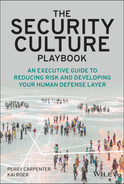Bibliography
- Betsy U., Nurse, J., Bada, M., and Furnell, S. (2021). Developing a cyber security culture: Current practices and future needs. Computers and Security Journal.
- @bjfogg. (March 31, 2011). 3 truths about human nature: We're lazy, social, and creatures of habit. Design products for this reality (accessed 28 January 2021).
https://twitter.com/bjfogg/status/53486588944056321?lang=en - Braue, D. (2021). Global ransomware damage costs predicted to exceed $265 billion by 2031. Cybercrime Magazine.
https://cybersecurityventures.com/global-ransomware-damage-costs-predicted-to-reach-250-billion-usd-by-2031 - Buss, M. (2017). Why you should be a culture carrier. Granify.
https://medium.com/granify/why-you-should-be-a-culture-carrier-e8ed0dfba6ce - Carpenter, P. (2019). Transformational Security Awareness: What Neuroscientists, Storytellers, and Marketers Can Teach Us About Driving Secure Behaviors. Wiley, 22–23.
- Chai, W. Confidentiality, integrity and availability (CIA triad). WhatIs.com. Updated 2021.
https://whatis.techtarget.com/definition/Confidentiality-integrity-and-availability-CIA - Childress, J. (2017). Culture Rules!: The 10 Core Principles of Corporate Culture and How to Use Them to Create Greater Business Success. Principia Associates.
- CMMI Institute Resource Center. DMM Model At-A-Glance. CMMI Institute (2019).
https://stage.cmmiinstitute.com/resource-files/public/dmm-model-at-a-glance - Da Veiga, A., & Eloff, J.H.P. A framework and assessment instrument for information security culture. Computers & Security. 2010; 29: 196–207.
- Dunn, S. (2014). Managing human error in maintenance. Assetivity.
www.assetivity.com.au/articles/reliability-improvement/managing-human-error-in-maintenance - Eriksen, A-C., Petrič, G., and Roer, K. (2021). Security culture and credential sharing: How improved security culture reduces credential sharing in cybersecurity.
www.knowbe4.com/hubfs/Security%20Culture%20and%20Credential%20Sharing.pdf - Fogg, B. J. Fogg Behavior Model (accessed 25 January 2021).
https://behaviormodel.org - Fogg, B. J. (2020). Tiny Habits: The Small Changes That Change Everything. Houghton Mifflin Harcourt.
- Fung, B. and Sands, G. (2021). Ransomware attackers used compromised password to access Colonial Pipeline. CNN.
www.cnn.com/2021/06/04/politics/colonial-pipeline-ransomware-attack-password/index.html - Hameed, M. and Arachchilage, N. (2021). The role of self-efficacy on the adoption of information systems security innovations: A meta-analysis assessment. Personal and Ubiquitous Computing; 25.
https://doi.org/10.1007/s00779-021-01560-1 - Hill, K. (2021). The Kaseya ransomware attack: A timeline. CSO.
www.csoonline.com/article/3626703/the-kaseya-ransomware-attack-a-timeline.html - IBM. (2021). How much does a data breach cost?
www.ibm.com/security/data-breach - Institute for Cybersecurity & Digital Trust. (2022). Cybersecurity Canon. Ohio State University.
https://icdt.osu.edu/cybercanon - International Data Corporation. (2021). IDC survey finds more than one third of organizations worldwide have experienced a ransomware attack or breach.
www.idc.com/getdoc.jsp?containerId=prUS48159121 - Internet Security Alliance. (2020). NCAD Director's Handbook on Cyber-Risk Oversight.
www.nacdonline.org/insights/publications.cfm?ItemNumber=67298 - Kahneman, D. (2013). Thinking, Fast and Slow. Farrar, Straus and Giroux.
- Khan, B., et al. (2011). Effectiveness of information security methods based on psychological theories. African Journal of Business Management; 5(26).
- KnowBe4. (2020). The Rise of Security Culture.
https://info.knowbe4.com/rise-of-security-culture - KnowBe4. Security Culture Survey (SCS). Updated 2022.
https://support.knowbe4.com/hc/en-us/articles/360037393134-What-Is-the-Security-Culture-Survey-SCS- - Lundy O, & Cowling A. Strategic Human Resource Management. Routledge; 1996.
- Martens, B. 11 Facts + stats on smishing (SMS phishing) in 2022. SafetyDetectives (accessed 29 January 2021).
www.safetydetectives.com/blog/what-is-smishing-sms-phishing-facts - Meyer, Erin. (2016). The Culture Map. PublicAffairs.
- Petrič, G. and Roer, K. (2022). The impact of formal and informal organizational norms on susceptibility to phishing: Combining survey and field experiment data. Telematics and Informatics; 67.
www.sciencedirect.com/science/article/pii/S0736585321002057 - Phishlabs. (2021). Quarterly threat trends & intelligence.
https://info.phishlabs.com/quarterly-threat-trends-and-intelligence-november-2021 - Pollini, A., et al. (2021). Leveraging human factors in cybersecurity: An integrated methodological approach. Cognition, Technology & Work.
https://doi.org/10.1007/s10111-021-00683-y - Register. The ransomware has gone nuclear (accessed 27 January 2021).
https://whitepapers.theregister.com/paper/view/8722/ransomware-has-gone-nuclear - Reuters. (2021). Meatpacker JBS says it paid equivalent of $11 mln in ransomware attack.
www.reuters.com/technology/jbs-paid-11-mln-response-ransomware-attack-2021-06-09 - Roberts, S. A. (2021). Exploring the Relationships Between User Cybersecurity Knowledge, Cybersecurity and Cybercrime Attitudes, and Online Risky Behaviors. Dissertation. Northcentral University.
- Schneier, B. (2000). Secrets and Lies: Digital Security in a Networked World. Wiley.
- Seals, T. (2021). Ransomware volumes hit record highs as 2021 wears on. Threat Post.
https://threatpost.com/ransomware-volumes-record-highs-2021/168327 - Sheridan, K. (2021). 85% of data breaches involve human interaction: Verizon DBIR. Dark Reading.
www.darkreading.com/operations/85--of-data-breaches-involve-human-interaction-verizon-dbir/d/d-id/1341012 - Sjouwerman, S. (2021). The latest ransomware attacks can require a data breach notification. KnowBe4.
https://blog.knowbe4.com/the-latest-ransomware-attacks-can-require-a-data-breach-notification - Stewart, G. and Lacey, D. (2012). Death by a Thousand Facts: Criticising the Technocratic Approach to Information Security Awareness. Inf. Manag. Comput. Secur. 20(1).
- Thaler, R. H. (2015). Misbehaving: The Making of Behavioral Economics. W. W. Norton & Co.
- Thaler, R. H. and Sunstein, C. R. (2009). Nudge: Improving Decisions About Health, Wealth, and Happiness. Penguin Books.
- Uchendu, B, et al. (2021). Developing a cyber security culture: Current practices and future needs. Computers & Security; 109.
- Verizon. 2021 Data Breach Investigations Report.
www.verizon.com/business/resources/reports/dbir
..................Content has been hidden....................
You can't read the all page of ebook, please click here login for view all page.
